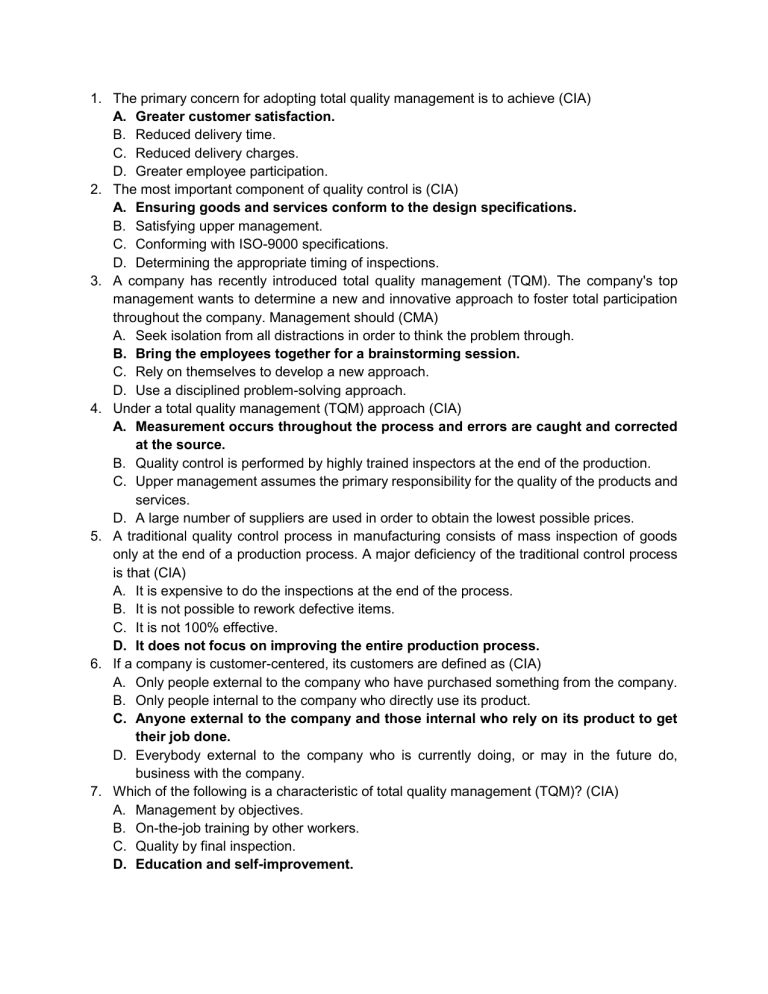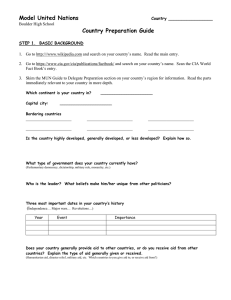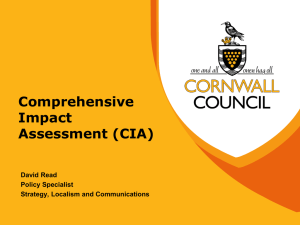
1. The primary concern for adopting total quality management is to achieve (CIA) A. Greater customer satisfaction. B. Reduced delivery time. C. Reduced delivery charges. D. Greater employee participation. 2. The most important component of quality control is (CIA) A. Ensuring goods and services conform to the design specifications. B. Satisfying upper management. C. Conforming with ISO-9000 specifications. D. Determining the appropriate timing of inspections. 3. A company has recently introduced total quality management (TQM). The company's top management wants to determine a new and innovative approach to foster total participation throughout the company. Management should (CMA) A. Seek isolation from all distractions in order to think the problem through. B. Bring the employees together for a brainstorming session. C. Rely on themselves to develop a new approach. D. Use a disciplined problem-solving approach. 4. Under a total quality management (TQM) approach (CIA) A. Measurement occurs throughout the process and errors are caught and corrected at the source. B. Quality control is performed by highly trained inspectors at the end of the production. C. Upper management assumes the primary responsibility for the quality of the products and services. D. A large number of suppliers are used in order to obtain the lowest possible prices. 5. A traditional quality control process in manufacturing consists of mass inspection of goods only at the end of a production process. A major deficiency of the traditional control process is that (CIA) A. It is expensive to do the inspections at the end of the process. B. It is not possible to rework defective items. C. It is not 100% effective. D. It does not focus on improving the entire production process. 6. If a company is customer-centered, its customers are defined as (CIA) A. Only people external to the company who have purchased something from the company. B. Only people internal to the company who directly use its product. C. Anyone external to the company and those internal who rely on its product to get their job done. D. Everybody external to the company who is currently doing, or may in the future do, business with the company. 7. Which of the following is a characteristic of total quality management (TQM)? (CIA) A. Management by objectives. B. On-the-job training by other workers. C. Quality by final inspection. D. Education and self-improvement. 8. In which of the following organizational structures does total quality management (TQM) work best? (CIA) A. Hierarchal. B. Teams of people from the same specialty. C. Teams of people from different specialties. D. Specialists working individual. 9. One of the main reasons that implementation of a total quality management program works better through the use of teams is (CIA) A. Teams are more efficient and help an organization reduce its staffing. B. Employee motivation is always higher for team members than for individual contributors. C. Teams are natural vehicle for sharing ideas, which leads to proceess improvement. D. The use of teams eliminates the need for supervision, thereby allowing a company to reduce staffing. 10. One of the main reasons total quality management (TQM) can be used as a strategic weapon is that (CIA) A. The cumulative improvement from a company's TQM efforts cannot readily be copied by competitors. B. Introducing new products can lure customers away from competitors. C. Reduced costs associated with better quality can support higher shareholder dividends. D. TQM provides a comprehensive planning process for a business. 11. Total quality management in a manufacturing environment is best exemplified by (CIA) A. Identifying and reworking production defects before sale. B. Designing the product to minimize defects. C. Performing inspections to isolate defects as early as possible. D. Making machine adjustments periodically to reduce defects. 12. Which of the following is not a characteristic of an innovative manufacturing company? (CIA) A. Emphasis on continuous improvement. B. Responsiveness to the changing manufacturing environment. C. Emphasis on existing products. D. Improved customer satisfaction through product quality. 13. Focusing on customers, promoting innovation, learning new philosophies, driving out fear, and providing extensive training are all elements of a major change in organizations. These elements are aimed primarily at (CIA) A. Copying leading organizations to better compete with them. B. Focusing on the total quality of products and services. C. Being efficient and effective at the same time, in order to indirectly affect profits. D. Managing costs of products and services better, in order to become the low-cost provider. 14. The International Standards Organization (ISO) has developed standards for ring networks that include fault management, configuration management, accounting management, security management, and performance monitoring. Which of the following controls is included in the performance-monitoring standards? (CIA) A. Reporting the failure of network fiber-optic lines. B. Recording unauthorized access violations. C. Compiling statistics on the number of times that application software is used. D. Allocating network costs to system users of the network. 15. Which of the following is a type of costing, that relates to the continuous accumulation of small betterment activities rather than innovative improvements? A. Target costing. B. Process costing. C. Variable costing. D. Kaizen costing. 16. The four categories of costs associated with product quality costs are (CMA) A. External failure, internal failure, prevention, and carrying. B. External failure, internal failure, prevention, and appraisal. C. External failure, internal failure, training, and appraisal. D. Warrant, product liability, training, and appraisal. 17. Quality is achieved more economically if the company focuses on (CMA) A. Appraisal costs. B. Prevention costs. C. Internal failure costs. D. External failure costs. 18. The management of a company is attempting to build a reputation as a world-class manufacturer of quality products. On which of the four costs should it spend the majority of its funds? (CIA) A. Prevention costs. B. Appraisal costs. C. Internal failure costs. D. External failure costs. 19. The cost of statistical quality control in a product quality cost system is categorized as (n) (CMA) A. External failure cost. B. Internal failure cost. C. Prevention cost D. Appraisal cost. 20. Product-quality related costs are part of a total quality control program. A product-quality related cost incurred in detecting individual products that do not conform to specifications is an example of a(n) (CMA) A. Prevention cost. B. Appraisal cost. C. Internal failure cost. D. External failure cost. 21. Management of a company is attempting to build a reputation as a world-class manufacturer of quality products. Which of the four costs would be the most damaging to its ability to build a reputation as a world-class manufacturer? (CIA) A. Prevention costs. B. Appraisal costs C. Internal failure costs. D. External failure costs. 22. The cost of scrap, rework and toolig changes in a product quality cost system is categorized as a (an) (CMA) A. Training cost. B. External failure cost. C. Internal failure cost. D. Opportunity cost. 23. The cost of statistical quality control in a product quality cost system is categorized as a (an) (CMA) A. Internal failure costs. B. Training costs. C. Prevention costs. D. Appraisal costs. 24. In a quality control program, which of the following is(are) categorized as internal failure costs? (AICPA/RPCPA) I. Rework. II. Responding to customer complaints. III. Statistical quality control procedures. A. I only. B. II only. C. III only. D. I, II, and III. 25. Nonfinancial performance measures are important to engineering and operations managers in assessing the quality levels of their products. Which of the following indicators can be used to measure product quality? (AICPA) I. Returns and allowances. II. Number and types of customer complaints. III. Production cycle time. A. I and II only. B. I and III only. C. II and III only. D. I, II, and III. 26. All of the following would generally be included in a cost-of-quality report except (CMA) A. Warranty claims. B. Design engineering. C. Supplier evaluations. D. Lost contribution margin. 27. Quality is achieved more economically if the company focuses on (CMA) A. Appraisal costs. B. Prevention costs. C. Internal failure costs. D. External failure costs. Questions 28 and 29 are based on the following information. Yahoo Corporation is a highly automated manufacturing firm. The Vice-President of Finance, Ferdinand, has decided that traditional standards are inappropriate for performance measures in an automated environment. Labor is insignificant in terms of the total cost of production and tends to be fixed. Materials quality are considered more important than minimizing material cost, and customer satisfaction is the number one priority. As a result, delivery performance measures have been chosen to evaluate performance. The following information is considered typical of the time involved to complete orders Wait time: from order being placed to start of production from start of production to completion 10.0 days 5.0 days Inspection time 1.5 days Process time 3.0 days Move time 2.5 days 28. What is the manufacturing cycle efficiency for this order? A. 25.0% B. 13.6% C. 37.5% D. 69.2% 29. What is the delivery cycle time for this order? A. 7 days. B. 12 days. C. 15 days. D. 22 days. 30. Quality costs indices are often used to measure analyze the cost of maintaining a given level quality. One example of a quality cost index, which uses a direct labor bases, is computed as Quality cost index = (Total quality costs / Direct labor costs) x 100 The following quality costs data were collected for May and June: May June P 4,000 P 5,000 6,000 5,000 Internal failure costs 12,000 15,000 External failure costs 14,000 11,000 Direct labor costs 90,000 100,000 Prevention costs Appraisal costs Based upon these cost data, the quality cost index (CIA) A. Decrease 4 points from May to June. B. Was unchanged from May to June. C. Increased 10 points from May to June. D. Decreased 10 points from ay to June. 31. In 2006, a manufacturing company instituted a total quality management (TQM) program producing the following report: Summary Cost of Quality Report (in thousands) 2005 2006 % Change P 200 P 300 +50 Appraisal costs 210 315 +50 Internal failure costs 190 114 -40 External failure costs 1,200 621 -48 Total Quality Costs 1,800 1,350 -25 Prevention costs On the basis of this report, which one of the following statements is most likely correct? (CMA) A. An increase in conformance costs resulted in a higher-quality product and a decrease in nonconformance costs. B. An increase in inspection costs was solely responsible for the decrease in quality costs. C. Quality costs such as scrap and rework decreased by 48%. D. Quality costs such as returns and repairs under warranty decreased by 40%. 32. Management of a company is attempting to build a reputation as a world-class manufacturer of quality products. Which of the following measures would not be used by the firm to measure quality? (CIA) A. The percentage of shipments returned by customers because of poor quality. B. The number parts shipped per day. C. The number of defective parts per million. D. The percentage of products passing quality tests the first time. 33. The Plan-Do-Chech-Act (PDCA) Cycle is a quality tool devised by W.E Deming. It is best described as (ING) A. A "management by fact" approach to continuous improvement. B. An ongoing evaluation of the practices of best-in-class organizations. C. The translation of customer requirements into design requirements. D. The responsibility of every employee, work group, department, or supplier to inspect the work. 34. The following information is available for Rocky Company for its 2 fiscal years: Year 1 Statistical process control Quality audits Year 2 P 70,000 P 100,000 35,000 50,000 Training 40,000 80,000 100,000 150,000 Rework 90,000 50,000 Spoilage 80,000 55,000 Warranties 180,000 80,000 Estimated customer losses 800,000 450,000 3,000,000 3,200,000 Inspection and testing Net sales In its cost of quality report for year 2, Rocky will disclose that the ratio of A. Conformance costs to total quality costs increased from 17.56% in year 1 to 37.44% in year 2. B. Nonconformance costs to total quality costs increased from 62. 56% in year 1 to 82.44% in year 2. C. Nonconformance costs to net sales equaled 19.84% in year 1. D. Conformance costs to net sales equaled 8.17% in year 2. 35. A company's Accounts Receivable Department processed 33,000 invoices during a 6-month period with a billing error rate of 3%. Each billing error cost P110 to correct. In addition, 15% of contract cancellations during this period were attributed to billing errors, resulting in estimated lost total contribution margin of P75,000 from dissatisfied customers who cancelled their contracts. If the number of invoices issued and the costs per billing error remain unchanged, the annual savings available for funding of a quality improvement program to lower the company's billing error rate by 1% (i.e., from 3% to 2%) would be (CMA) A. P 61,300 B. P122,600 C. P222,400 D. P267,800 36. Which of the following statements regarding benchmarking is false? A. Benchmarking involves continuously evaluating the practices of best-in class organizations and adapting company processes to incorporate the best of these practices. B. Benchmarking in practice usually involves a company forming benchmarking teams. C. Benchmarking is an ongoing process that entails quantitative and qualitative measurement of the difference between the company's performance of an activity and the performance by the best in the world or the best in the industry. D. The benchmarking organization against which a firm is comparing itself must be a direct competitor. 37. An example of an internal nonfinancial benchmark is (CIA) A. The labor rate of comparably skilled employees at a major competitor's plant. B. The average actual cost per pound of a specific product at the company's most efficient plant becoming the benchmark for the company's other plants. C. The company setting a benchmark of P50,000 for employee training programs at each of the company's plants. 38. 39. 40. 41. 42. 43. 44. D. The percentage of customer orders delivered on time at the company's most efficient plant becoming the benchmark for the company's other plants. Comparing one's own product, service or practice with the best known similar activity is A. Actual costing. B. Benchmarking. C. Backflush costing. D. Budgeting. The quantity of output divided by the quantity of one input equals A. Gross margin. B. Residual income. C. Practical capacity. D. Partial productivity. A manufacturing cell's partial productivity can be measured using data on A. Inventory shrinkage. B. Inventory turnover. C. Direct materials usage. D. Scrap. Productivity is defined as the ratio of output of a production process to the input that are used. Consider a process that currently produces 2,000 units of output with 500 hours of labor per day. This process can be redesigned to produce 2,520 units of output requiring 600 hours per day. The percentage change in productivity from redesigning the process is (CMA) A. 5% B. 10% C. 20% D. 26% MBO managers are most likely to believe that employees A. Dislike their work. B. Avoid responsibility whenever possible. C. Work best when threatened with punishment. D. Are self-motivated. A budget is often the result of a management-by-objective (MBO) program. A characteristic of MBO is A. Development of a single measure of employee performance. B. Statement of objectives through both top-down and bottom-up processes. C. Establishment of objectives through both top-down and bottom-up processes. D. A flexible time frame for achievement of objectives. Which of the following is a weakness of using MBO for motivating employees? A. Employees may believe that they control situations that arise in the company. B. Employees may be forced to place too much emphasis on quantitative factors. C. Employees may participate too much in the goal-setting process. D. Employees may become too trusting and too dependent on the "team" to get things done.

